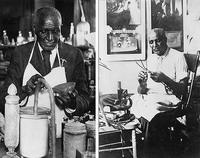Login form
George Washington Carver
 When George Washington Carver looked at peanuts he saw more than a nut in a shell. He saw opportunity for farmers in the Southern United States. This great American agricultural scientist found more than 300 uses for the peanut and other plants. From peanuts, Carver made soap, ink, flour, axle grease, and other products. Many Southern farmers raised cotton. He showed farmers the value of raising other crops. He also showed them how to improve the soil.
When George Washington Carver looked at peanuts he saw more than a nut in a shell. He saw opportunity for farmers in the Southern United States. This great American agricultural scientist found more than 300 uses for the peanut and other plants. From peanuts, Carver made soap, ink, flour, axle grease, and other products. Many Southern farmers raised cotton. He showed farmers the value of raising other crops. He also showed them how to improve the soil.
HIS EARLY LIFE
George Washington Carver was born on a farm near Diamond, Missouri, in 1864. His parents were slaves.
The Civil War was being fought when he was born, and the slaves were soon freed. When he was ten years old, he left the farm and began working his way through school.
After he finished high school, he worked his way through Iowa State College of Agriculture and Mechanic Arts (now Iowa State University). When he graduated, he went to work at the college, teaching and doing research.
CARVER’S RESEARCH
In 1896, Carver became director of the Department of Agricultural Research at Tuskegee Normal and Industrial Institute (now Tuskegee University) in Alabama. It was then that he began to experiment with peanuts.
In addition to finding new uses for peanuts, he found industrial uses for sweet potatoes and soybeans. He developed a new type of cotton known as Carver's hybrid. He also taught ways of making soil better for growing crops.
AWARDS AND HONORS
Carver earned many awards and honors for his work. In 1923, the National Association for the Advancement of Colored People (NAACP) awarded him the Spingarn Medal. In 1935, he was appointed to an important position in the U.S. Department of Agriculture. In 1940, he donated his savings to establish the George Washington Carver Foundation at Tuskegee for agricultural research. Carver died at Tuskegee on January 5, 1943. The farm in Missouri where he was born became the George Washington Carver National Monument in 1943.
Source: Microsoft ® Encarta

